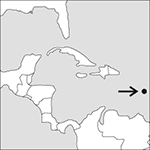
Source: MAPS IN MINUTES™ © RH Publications (1997)
Capital:
Castries
Area:
616 sq km (238 sq miles)
Population:
162,781 (2013 est)
Currency:
1 East Caribbean dollar = 100 cents
Religions:
Roman Catholic 61.5%; Seventh-day Adventist 10.4%; Pentecostal 8.9%
Ethnic Groups:
Black 85.3%; mixed 10.9%; East Indian 2.2%
Languages:
English (official); French patois
International Organizations:
UN; OAS; CARICOM; Commonwealth; Non-Aligned Movement; WTO
An island country, one of the Windward Islands of the Caribbean.
Physical
Saint Lucia is 43 km (27 miles) in length and roughly oval-shaped. In the south-west is the dormant volcano Qualibou. The twin peaks of the Pitons have fine volcanic cones. The fertile volcanic valleys and coastal plains are well watered. There is a fine harbour.
Economy
Tourism generates almost two-thirds of GDP and is the main source of foreign exchange. Other industries include clothing, assembly of electronic components, and drinks; offshore banking is also important. Bananas, coconuts, fruit, vegetables, and cocoa are grown.
History
The Arawak Indians, the earliest inhabitants of Saint Lucia, were driven out by Carib Indians before Europeans arrived. The British failed in their attempts to colonize the island in 1605 and 1638 and the French settled it, making a treaty with the Caribs in 1660. Saint Lucia changed hands several times before being ceded to Britain in 1814. A representative local government was established in 1924 and Saint Lucia was a member of the Federation of the West Indies from 1958 until 1962. Saint Lucia became an independent member of the British Commonwealth in 1979, after twelve years of internal self-government. Its economy has been severely affected by the fall in the price of bananas (its then chief export) in the European market in 1993.
- means-tested benefits
- mean sun
- mean time
- mean time between failures
- mean time to failure
- mean value(of a function)
- mean value theorem
- mean-variance preferences
- mean velocity
- measurable function
- measurable set
- measurand
- measure
- measurement
- measurement error
- measurement of appearance
- measurements of central tendency
- measure of agreement
- measure of association
- measure of goodness-of-fit
- measure of location
- measure of spread
- measures of location
- measures of variation
- measure space